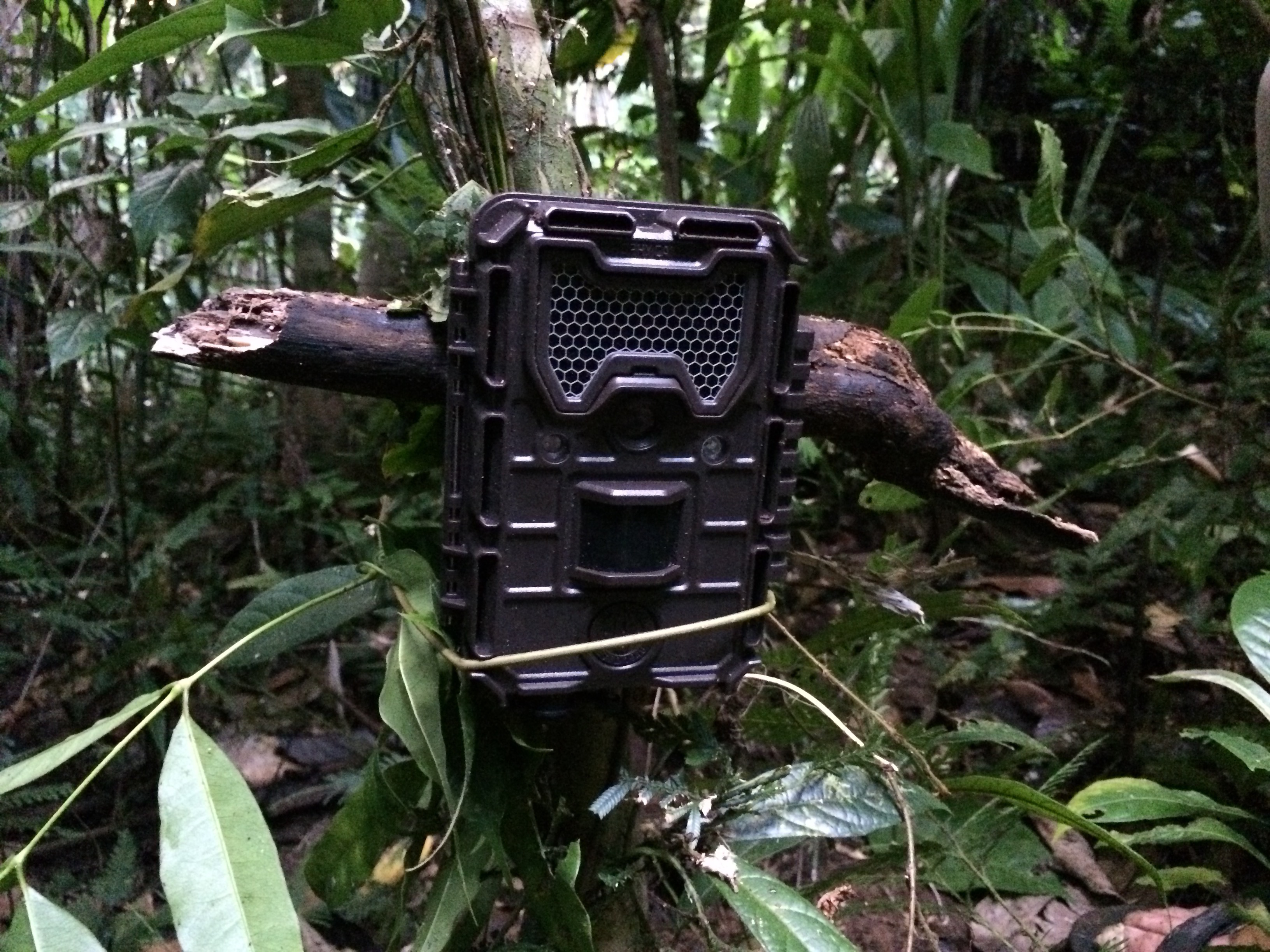Even with camera traps, catching a bird-of-paradise isn’t easy.
“I’m hopping with excitement!” says Timothy Boucher, who is quite literally hopping down the trail with excitement. It’s 8:00 a.m. in the morning in the Papua New Guinea rainforest, and we’re looking for a bird-of-paradise.
Suddenly, an explosive set of rapid churrr calls ring above our heads. “Magnificent,” Boucher mouths over his shoulder. It’s a Magnificent Bird-of-Paradise, and it’s close. Really close. More calls, and a dark shape flashes through the lek. And then silence.
We give up an hour later. Mosquito-bitten and sodden with sweat, we know the bird isn’t coming back anytime soon. We’ll just have to wait for the camera trap footage.
Conservancy conservation geographer and expert birder Timothy Boucher and I are in the midst of an expedition to the Adelbert Mountains to collect acoustic sampling data on land use types. While we’re there, we’re using camera traps to try and verify the presence of some key conservation species, like birds-of-paradise.
Even with camera traps, catching a bird-of-paradise isn’t easy.
Justine E. Hausheer
A Dance Site in the Forest
Late the previous afternoon, local scouts arrived at the hilltop outpost where we’d set up camp for the day. Through local Conservancy staffer Cosmas Apelis, they told us that they’d found a bird-of-paradise lek, or display site, in the forest.
“The male clears a little area in the forest of leaves where it displays for the females, who are hopefully watching in the distance,” explains Boucher. “So it hops around and does its thing, and if it is successful it goes off and breeds.”
We didn’t know what species — they call all bird-of-paradise species kumul — and we didn’t know how far away. Could we get there and deploy the camera trap by sundown? Maybe.
We set off through the forest, winding steadily down the opposite side of the ridge we’d climbed that morning. After 30 minutes we turned left and walked along a trickling streambed until our guide motioned up another nearly invisible path.
We didn’t see the lek until we were on top of it, nearly stumbling into the 1.5-meter wide space of clear earth on the forest floor. Three arm-thick saplings grew in the clearing, which was bare except for handful of large, dark, seemingly intentionally placed leaves.





The Magnificent Bird-of-Paradise is one of 39 bird-of-paradise species found in New Guinea, Australia, and their surrounding islands. Male Magnificents have vivid yellow wings, blue legs and feet, and an iridescent green breast, which they flash at females during courtship displays on the lek.
Common but difficult to see, they’re found in lower mountain forests throughout the island. They and the other nine bird-of-paradise species in the Adelberts are some of the target species in the Conservancy’s local conservation land-use planning efforts. But even with the help of camera traps, all of the bird-of-paradise species are incredibly difficult to locate.
Conservancy lead scientist Eddie Game and Princeton University tropical forest ecologist Zuzana Burivalova are here in the Adelberts with Boucher to gather acoustic sampling data — recording the soundscape of the forest — which they will use to assess the health of conservation areas and other land use types set aside by three villages.
“The camera traps will add additional data to the acoustic recorders that we’re using,” says Boucher. “And its also just great to see what is going on out in the forest.”
We decide to strap the camera on a sturdy-looking tree at the edge of the clearing, wedging a thick chunk of wood behind it to get the downward angle exactly right.
“I hope we get it dancing,” says Boucher, checking the angle one last time. As a last-minute precaution, he cuts some vine from the undergrowth and ties a second, impromptu strap. Just in case.
The camera traps we are using are equipped to take still images or video (we chose video), and will work throughout the day and night thanks to an infrared camera.
Our first set of footage from the Musiamunat conservation area caught a tree rat scuttling across a vine at dawn — the first and only wild mammal we’ve seen the entire trip, with the exception of a furry something that ran over our feet in the middle of the night.
The Moment of Truth
It’s mid-afternoon when the conservation ranger from Yavera comes jogging into the village, a rucksack filled with recorders and camera traps strapped to his back. Thanking him quickly, we whip open the panel on the camera, grab Game’s computer, and pop in the SD card.
Boucher presses play on the first clip: Shaking leaves. The second and third: tree rats scuttling across the forest floor.
Then Boucher cues up clip number four. Holding our breath, we all watch as a Magnificent Bird-of-Paradise hops into frame. “You’re totally going to get it, look at those wires!” says Game, referring to the reflective, wire-like spiral feathers protruding from the bird’s tail.
We all pile in ontop of each other as Boucher hits play on the next 30-second clip. The male bird jumps full into frame this time — yellow plumage flashing, spirals jangling — and proceeds to meticulously clean his dancing site.
“Oh my gosh!” Boucher yells. Now we’re all hopping with excitement, high-fiving and hugging. Clip after clip of the Magnificent Bird-of-Paradise loads on the screen — the male was on the lek all morning — and in one clip a female comes to inspect his handiwork.
By the end of the trip we logged the Magnificent Bird-of-Paradise, a wild boar, several tree rats or other mysterious small mammals, a Banded Yellow Robin, a Red-legged Brushturkey, a Pheasant Pigeon, and one rather large insect.
“We stalked that bird for quite a while, and then we just had to sit and wait for the footage,” says Boucher. “I think the anticipation nearly killed me.”



Join the Discussion